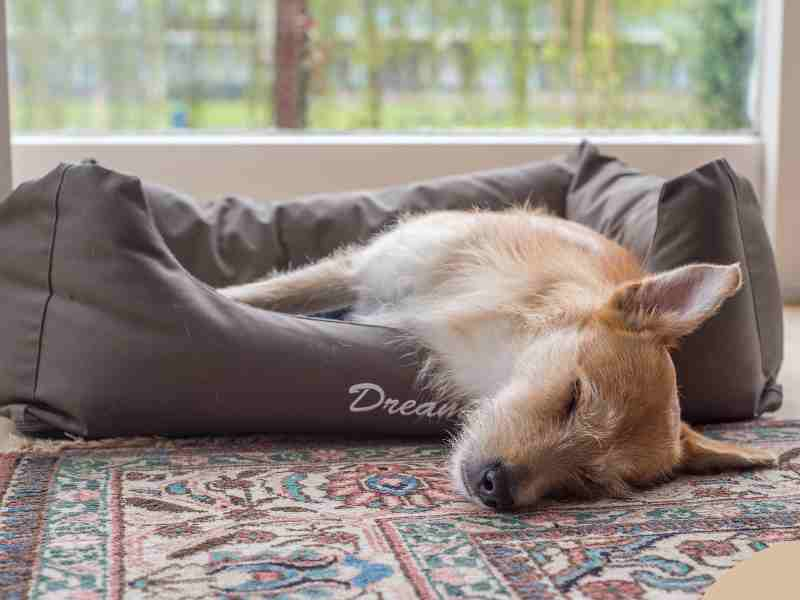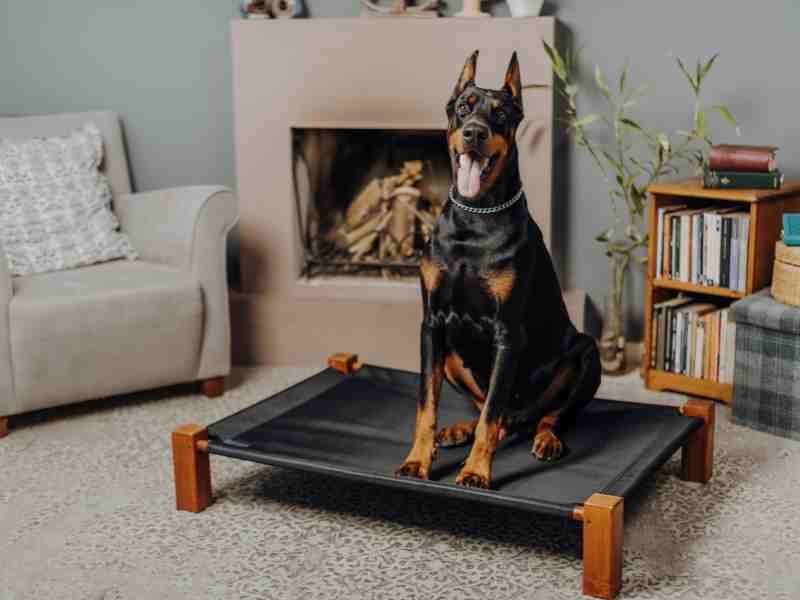Selecting the perfect dog bed is an important part of taking care of your dog. It’s not just about a comfortable spot for them to snooze; it’s about supporting their health and mobility, particularly as they age or if they face mobility challenges. From plush comforts for puppies to supportive solutions for older dogs, the right bed (and location) really does affect their quality of life. How can you choose the right dog bed for mobility and comfort? We’ve got thoughts!
Understanding Mobility Needs in Dogs
It’s no secret that many dogs develop mobility issues as they age, with common conditions like arthritis and hip dysplasia being more and more prevalent. These conditions cause pain and stiffness, which can severely limit your pet’s ability to move around comfortably, and that can affect their quality of life. But mobility issues aren’t just concerns for older dogs; younger dogs also benefit from preventive measures for their mobility, and it starts with something as basic as where they sleep.
The right bed plays a critical role in managing mobility issues in dogs. A supportive bed provides relief from the discomfort of hard floors and helps distribute weight evenly, reducing pressure on sore joints. This can be particularly beneficial after a long day of play or during recovery from surgery. And, it’s about more than just the right bed. It’s also about the right beds, and at the right location, or locations. Choosing the right bed for dogs may mean having several different options throughout your home to meet their different needs during the day.
For younger dogs, think of a supportive bed as part of a long-term health strategy. Starting with the right bed early in life may help prevent the development of joint problems and other mobility issues. Just like we humans invest in good mattresses to avoid back problems, the same concept applies to our best friends—preventative care through proper support is key, and can make a huge difference on their lifelong quality of life.
Choosing beds with the right support and materials means you’re not just providing a comfortable spot for your dog to rest but actively contributing to their overall health and longevity.
Enhancing Mobility for Dogs of All Ages with the Right Bedding
Often we think of our dogs having ‘their bed’ and that’s that. The truth is, providing a variety of bed types throughout your home makes sure that they can find the perfect spot to support their activity level and health needs. That doesn’t mean you have to spend mega dollars on the same bed throughout the house, but instead, offer more diversity for them when they are resting and sleeping. It can be as easy as having an inexpensive, movable mat throughout your house, but it also depends on your dog and what they gravitate to.
To figure that out, you really just need to pay attention to where they tend to rest. Do you find them on the carpet more often than not? The sofa? The mat in their crate? Tile/solid floor? A mix? Your dog may want a fluffy bed at night but something thinner and cooler in the morning, and then by the end of the day, it needs something a bit more supportive before falling back into fluffy dreams again. It’s really about watching them and analyzing and then trying to meet their needs based on what you see they gravitate to. Some common dog bed styles for mobility and vitality include:
- Orthopedic Beds: Ideal for dogs at any age, orthopedic beds feature thick, dense memory foam that molds to your dog’s body, providing exceptional support and easing pressure on joints. These beds are particularly beneficial for maintaining joint health, alleviating discomfort, and making it easier for your dog to get up and move. They’re a great preventative measure for younger dogs and a comfort must-have for older dogs. They often have raised sides or bolsters that offer a place for your dog to rest their head and increase security and comfort, creating a nest-like space.
- Memory Foam: Adapts to the shape of your dog to provide customized support, crucial for minimizing joint strain and enhancing mobility. They come in a variety of shapes and sizes and sometimes overlap as orthopedic dog beds but sometimes they’re just flat mats of memory foam for molding.
- Heated Beds: These beds are a win in colder climates, helping to relax and soothe stiff muscles and joints, and providing gentle warmth that enhances comfort and mobility. But, they also offer support to older dogs who may be dealing with stiff joints, and you can sometimes find orthopedic beds to be heated as well.
- Soft Beds: Plush and inviting, soft beds are perfect for relaxation and sleep, especially in quieter, private areas of your home, like bedrooms. They’re usually the ones you marvel over as well, and can be cozy and comfy for puppies to senior dogs.
- Rigid Beds: Offering firmer support, rigid beds are excellent for dogs who need help getting up. They are also easier to clean and maintain, making them ideal for busy areas of the house or even outdoor spaces where your dog can enjoy family activities. Popular rigid beds are similar to cots in design.
The key, really, is strategically placing a variety of beds around your home—from soft, snug spots for overnight sleeping to supportive, accessible beds for daytime activities. Doing so allows you to empower your dog to choose the best spot for their comfort and mobility needs at any moment. This enhances their comfort and actively supports their ability to move freely and painlessly throughout their environment, fostering better mobility and a higher quality of life.
Innovative and Flexible Dog Bedding Solutions
The typical image of dog beds is a fluffy cushion or a structured orthopedic mattress. However, for households with or without mobility-challenged dogs, thinking outside the traditional bed box can lead to more adaptable and versatile solutions. Here are some creative, out-of-the-box dog bedding ideas that can greatly benefit your pet, especially if they need easy access to comfort in various home spaces.
Yoga Mats: Lightweight and portable, yoga mats can be an excellent alternative for dogs that need a soft landing wherever they go. These mats can be rolled out anywhere, providing a familiar surface in different rooms of the house. This is particularly useful if your dog likes to follow you around but needs consistent joint support. Yoga mats are also easy to clean and replace, making them a convenient choice for active spaces like the kitchen or laundry room. They’re also super easy to take with you wherever you are in your home and your dog will appreciate the secure spot you can offer them everywhere they go.
Interlocking Foam Tiles: Similar to yoga mats, interlocking foam tiles offer customizable and movable flooring solutions. You can assemble them in any room, creating a soft mat for your dog to rest or play. These tiles cushion joints while being sturdy enough to support movement and make them ideal for creating a designated ‘safe zone’ for play and relaxation.
Bean Bags: A bean bag can be a fantastic option for dogs that enjoy nestling into their sleeping spots. Bean bags mold to the body’s shape, providing soft, enveloping comfort that can relieve pressure on joints. They can be moved easily from room to room and are often made with durable, washable materials.
Cot-style Beds: Elevated cot-style beds are not the typical indoor bedding choice, but they offer unique advantages. They keep dogs off cold, hard floors and ensure consistent airflow around their body, which can help reduce overheating. Their firmness provides easy access for dogs who struggle to get up from lower surfaces, and they can be stationed in sunny spots for a warm nap or in breezy areas to help cool down.
Travel Beds: Compact and foldable, travel beds are designed to be on-the-go but can be just as useful at home for dogs that need familiar bedding in different parts of the house. They can be unfolded in any room, providing a recognized comfort zone that can soothe anxiety and offer a sense of security.
Having a variety of options for your dog to find what makes them the most comfortable isn’t just about their comfort but also your flexibility in managing your dog’s mobility needs. The goal is always for them to live comfortably and happily in their environment, and giving them choices is a great way to do so.
Positioning beds in various locations around the house ensures that your dog has access to comfort no matter where they are. For example, placing a bed in the living room allows them to rest comfortably while still being part of family activities. Similarly, a bed near the entrance can help older dogs or those with mobility issues stay connected with comings and goings without having to move too far.
Benefits of Variety: Offering different types of beds in these strategic locations caters to your dog’s changing needs throughout the day and year:
- Cool Beds: In warmer areas or during hot seasons, beds made from materials that help dissipate heat can provide a wonderful retreat. Cooling gel beds or elevated beds that allow for better airflow are perfect for keeping your dog comfortable during the summer months, or any time of the year, depending on the climate and their needs.
- Elevated Beds: These beds are not only great for keeping your dog cool but also provide easier access for dogs with mobility issues. The slight elevation helps dogs step in and out of bed with less effort, especially for those with stiff joints or arthritis.
- Soft Beds: Placing soft, cushioned beds in quiet, secluded areas of your home offers a sanctuary for rest and relaxation. These areas become safe havens where your dog can unwind completely and sleep undisturbed, which is crucial for recovery and their mental and physical health.
Choosing the Right Bed Material and Design for Your Dog
Selecting the right material and design for your dog’s bed is crucial because you need to make sure it provides the support, comfort, and cleanliness that your pet needs. Here are a few tips to help you find the best options that cater to your dog’s unique requirements and preferences.
Materials for Support and Comfort:
- Memory Foam: Ideal for support, memory foam beds conform to your dog’s body, helping to distribute weight evenly and reduce pressure on joints. This is especially beneficial for dogs with arthritis or other mobility issues.
- Orthopedic Foam: Similar to memory foam, orthopedic foam is specifically designed to provide extra support and is excellent for older dogs or those with chronic pain.
- Polyester Fill: Polyester-filled beds can be very comfortable for dogs that prefer a softer feel. However, they offer less support and may not be suitable for dogs with significant joint issues.
Hypoallergenic and Easy-to-Clean Options:
- Hypoallergenic Materials: Dogs with allergies or sensitive skin will likely benefit from beds made with hypoallergenic materials that prevent allergens/irritants like dust mites and mold.
- Water-resistant Covers: Easy to clean and ideal for dogs with incontinence issues, water-resistant covers help maintain hygiene and extend the bed’s lifespan. Plus, it’s much easier for you to clean up.
- Removable Covers: Beds with removable covers are convenient for regular washing, helping you keep odors and allergens at bay. Keep in mind that not all removable cover beds are equal, and just because a cover comes off doesn’t mean it goes back on as easily. Keep that in mind when shopping.
Choosing the Right Size and Shape of Dog Bed:
- Size: Make sure the bed is large enough for your dog to lie down comfortably in all natural positions that they might get in. A good rule of thumb is to measure your dog from nose to tail while they’re sleeping and add a few inches to each side for comfort.
- Shape: Consider your dog’s sleeping habits. If they like to stretch out, a rectangular bed might be best. A round or oval bed can provide a cozy nest for dogs that often curl up.
- Raised Edges: Dogs who like to rest their heads on an arm or pillow might prefer beds with bolsters or raised edges, which can also provide a sense of security for them.
Whatever you choose, a well-chosen bed is often a long-term investment in your dog’s overall well-being and can support them throughout their different life stages.
Additional Considerations When Buying Dog Beds
Choosing the right beds and placing them thoughtfully around your home are important steps, but there are additional considerations to ensure your dog fully benefits from their resting and sleeping arrangements. It’s important to effectively introduce new beds and adjust them as your dog’s needs change and maintain them over time.
Introducing a New Bed to Your Dog:
- Familiarity: Place a new bed in a familiar spot where your old bed used to be to help your dog adjust more quickly.
- Encouragement: Encourage your dog to explore and use new bedding by placing their favorite toys or a piece of your clothing on it to make it more appealing and comforting.
- Positive Reinforcement: Use treats and affection to reward your dog for using a bed you want them to get used to, reinforcing it as a positive space for them.
Adjusting Bed Types and Placement Over Time:
- Monitor Changes: As your dog ages or their mobility changes, their bed needs will likely change as well. Keep an eye on how easily they get in and out of the bed and whether they seem comfortable and supported.
- Adaptation: Consider switching to more supportive beds like orthopedic foam beds or elevated beds as your dog grows older or if their mobility decreases. You may also find that you need to relocate beds to more accessible areas if your dog starts having trouble moving around.
- Variety: Maintain a variety of beds around the house to accommodate your dog’s changing preferences and needs. For instance, you might introduce cooler, more breathable beds in the summer or warmer, plush beds in the winter. You know your dog best, so don’t be afraid to be unconventional if it makes your dog happy and comfy.
Regular Bed Maintenance and Replacement:
- Cleaning Routine: Regular bed cleaning is important to prevent the build-up of dirt, hair, and allergens. Follow care instructions for washing and drying bed covers and replace fill materials if they start to lose their shape.
- Inspection: Regularly inspect the bed for signs of wear and tear, especially if your dog enjoys chewing or digging. Safety is important, and damaged beds can pose risks, as many dogs have ended up with blockages from something they’ve chewed.
- Replacement: Generally, a good quality dog bed should last several years, but be prepared to replace it if it no longer provides the necessary support or comfort or if it becomes too worn out to clean effectively.
Your dog’s rest is an important part of their daily life. Choosing the right dog bed (or beds) can make sure that it’s a comfortable and supportive part of their daily life, and that means a happier, healthier dog!


